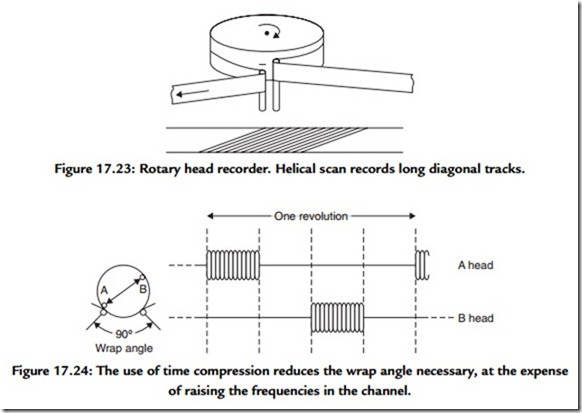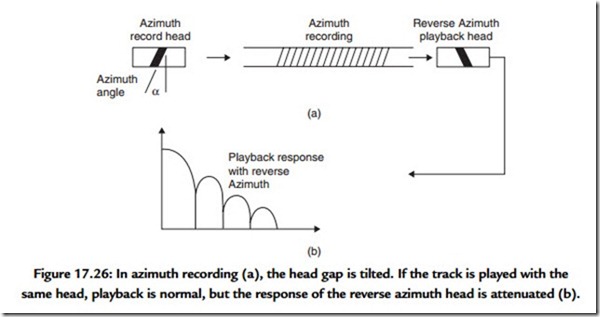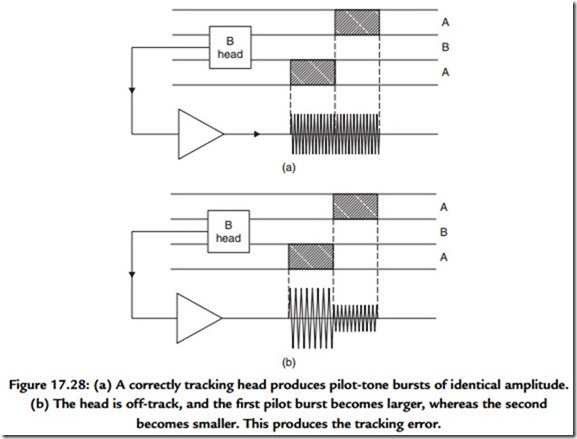Rotary Head Digital Recorders
The rotary head recorder borrows technology from video recorders. Rotary heads have a number of advantages over stationary heads. One of these is extremely high packing density: the number of data bits that can be recorded in a given space. In a digital audio recorder, packing density directly translates into the playing time available for a given size of the medium.
In a rotary head recorder, the heads are mounted in a revolving drum and the tape is wrapped around the surface of the drum in a helix, as can be seen in Figure 17.23. The helical tape path results in the heads traversing the tape in a series of diagonal or slanting tracks. The space between the tracks is controlled not by head design but by the speed of the tape, and in modern recorders this space is reduced to zero with a corresponding improvement in packing density.
The added complexity of the rotating heads and the circuitry necessary to control them are offset by the improvement in density. The discontinuous tracks of the rotary head recorder are naturally compatible with time-compressed data. As Figure 17.24 illustrates, the audio samples are time compressed into blocks, each of which can be contained in one slant track.
In a machine such as RDAT, there are two heads mounted on opposite sides of the drum. One rotation of the drum lays down two tracks. Effective concealment can be had by recording odd-numbered samples on one track of the pair and even-numbered samples on the other. Samples from the two audio channels are multiplexed into one data stream, which is shared between the two heads.
As can be seen from the block diagram shown in Figure 17.25, a rotary head recorder contains the same basic steps as any digital audio recorder. The record side needs ADCs, time compression, the addition of redundancy for error correction, and channel coding. On replay the channel coding is reversed by the data separator, errors are broken up by
the deinterleave process and corrected or concealed, and the time compression and any fluctuations from the transport are removed by time base correction. The corrected, time- stable samples are then fed to the DAC.
One of the reasons for the phenomenal recording density at which RDAT operates is the use of azimuth recording. In this technique, alternate tracks on the tape are laid down with heads having different azimuth angles. In a two-headed machine this is easily accommodated by having one head set at each angle. If the correct azimuth head subsequently reads the track there is no difficulty, but as Figure 17.26 shows, the wrong head suffers a gross azimuth error.
Azimuth error causes phase shifts to occur across the width of the track and, at some wavelengths, this will result in cancellation except at very long wavelengths where the process is no longer effective. The use of 8110 channel coding in RDAT ensures that no low frequencies are present in the recorded signal and so this characteristic of azimuth recording is not a problem. As a result the pickup of signals from the adjacent track is effectively prevented, and the tracks can be physically touching with no guard bands being necessary.
As the azimuth system effectively isolates the tracks from one another, the replay head can usually be made wider than the track. A typical figure is 50% wider. A tracking error of up to +/- 25% of the track width then causes no loss of signal quality.
In practice the same heads can also be used for recording, even though they are too wide. As can be seen in Figure 17.27, the excess track width is simply overwritten during the next head sweep. Erase heads are unnecessary, as the overlapping of the recorded tracks guarantees that the whole area of a previous recording is overwritten. A further advantage of the system is that more than one track width can be supported by the same mechanism simply by changing the linear tape speed. Prerecorded tapes made by contact duplication have lower coercivity coatings, and to maintain the signal level the tracks are simply made wider by raising the tape speed. Any RDAT machine can play such a recording without adjustment.
In any rotary head recorder, some mechanism is necessary to synchronize the linear position of the tape to the rotation of the heads, otherwise the recorded tracks cannot be replayed. In a conventional video recorder, this is the function of the control track, which requires an additional, stationary head. In RDAT the control track is dispensed with, and tracking is obtained by reading patterns in the slant tracks with the normal playback heads.
Figure 17.28 shows how the system works. The tracks are divided into five areas. PCM audio data are in the center and subcode data are at the ends. Audio and subcode data are separated by tracking patterns. The tracking patterns are recorded and played back along with data. The tracking is measured by comparing the level of a pilot signal picked up from the tracks on each side of the wanted track. If the replay head drifts toward one side, it will overlap the next track on that side by a greater amount and cause a larger pilot signal to be picked up. Pilot pickup from the track on the opposite side will be reduced. The difference between the pilot levels is used to change the speed of the capstan, which has the effect of correcting the tracking.
Ordinarily, azimuth effect prevents the adjacent tracks being read, but the pilot tones are recorded with a wavelength much longer than that of data. They can then be picked up by a head of the wrong azimuth.
The combination of azimuth recording, an active tracking system, and high coercivity tape (1500 Oersteds compared to 200 Oersteds for analogue audio tape) allows the tracks to be incredibly narrow. Heads of 20 μm width write tracks 13 μm wide. About 10 such tracks will fit in the groove of a vinyl disc. Although the head drum spins at 2000 rpm, the tape speed needed is only 8.15 mm per second.
The subcode of RDAT functions in a variety of ways. In consumer devices, the subcode works in the same way as in CD, having a table of contents and flags allowing rapid access to the beginning of tracks and carrying signals to give a playing time readout.
In professional RDAT machines, the subcode is used to record time code. A time code format based on hours, minutes, seconds, and DAT frames (where a DAT frame is one drum revolution) is recorded on the tape, but suitable machines can convert the tape code to any video, audio, or film time code and operate synchronized to a time code reference. As the heads are wider than the tracks, a useful proportion of the data can be read even when the tape is being shuttled. Subcode data are repeated many times so that they can be read at any speed. In this way an RDAT machine can chase any other machine and remain synchronized to it.
While there is nothing wrong with the performance of RDAT, it ran into serious political problems because its ability to copy without loss of quality was seen as a threat by copyright organizations. The launch of RDAT as a consumer product was effectively blocked until a system called serial copying management system was incorporated. This allows a single generation of RDAT copying of copyright material. If an attempt is made to copy a copy, a special flag on the copy tape defeats recording on the second machine.
In the meantime, RDAT found favor in the professional audio community where it offered exceptional sound quality at a fraction of the price of professional equipment. Between them, the rapid access of hard disc-based recorders and the low cost of RDAT have effectively rendered %inch analogue recorders and stereo open reel digital recorders obsolete.




